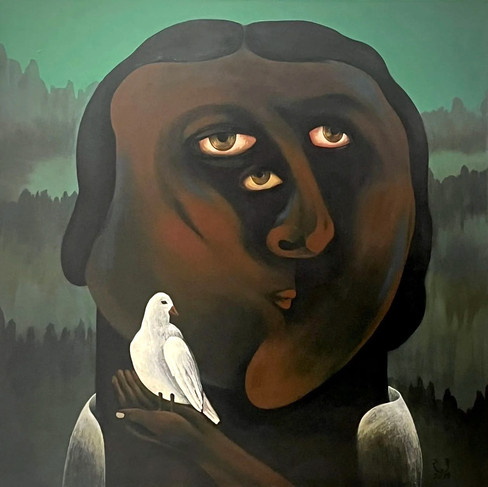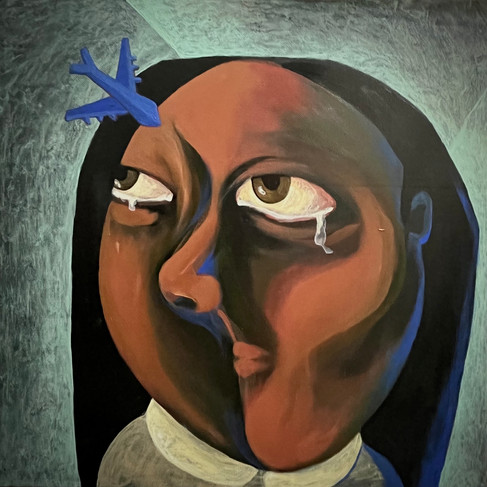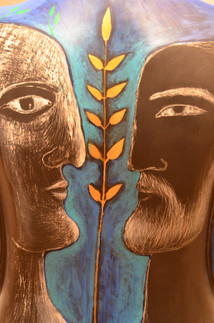Artist Spotlight - A Journey of Artistic Courage
- CARAVAN Arts
- Feb 6
- 7 min read
Updated: Feb 7
An Interview with noted Egyptian artist Souad Abdelrasoul
Our president, Paul G. Chandler, had the privilege of visiting the noted Egyptian artist Souad Abdelrasoul in her studio in Cairo during his last trip to Egypt. Souad had previously participated in CARAVAN’s exhibition titled AMEN: A Prayer for the World (see photos at end of interview).
“My work is about me. My inspiration comes from my own lived experience . . . In every artistic adventure, I was getting to
know a part of my soul.”
Souad Abdelrasoul


Souad Abdelrasoul was born in 1974 in the historic Shubra neighborhood of Cairo, Egypt, and currently lives and works in southern Cairo. She graduated in 1998 from the Faculty of Fine Arts in Cairo, and in 2005 she completed her master’s degree in History of Art, and in 2012 her PhD in Modern Art History. She has exhibited her work since 1998. Her artistic practice spans the mediums of drawing, painting, sculpture and graphic design, that fuses the abstract and figurative. By depicting metamorphosed figures, Souad reflects on the connections between humanity and nature. “We are part of the earth and the earth is definitely a part of each of us,” she says. Tree-like figures, branching veins and arteries, and animalesque characters merge on her canvases to remind viewers of the vital bond between the interior and the exterior. By doing this, Souad reconceptualizes the way we perceive space and repurposes notions of body, science, and nature into something strikingly personal. Souad also designs books and/or book covers for children, and conducts children's art workshops.
The Almas Art Foundation published a book about Souad and her art titled Like a Single Pomegranate (2023), and she is featured in Phaidon’s Great Women Painters (2022). She has been the subject of numerous magazine articles as well.
For more information - via Instagram: @souadabdelrasoul
View two short documentaries about Souad:
____________________________________
I would love to hear how you became an artist. Can you share how that came about, and what most influenced you in your artistic journey?
Souad: I remember that I loved art from a young age. During my childhood, I liked to observe drawings of curtains, bedspreads, sheets, illustrated novel and magazine covers, and drawings of chocolate and tobacco boxes. They all awakened my curiosity. I loved drawing and sewing dresses for my plastic dolls, and also making dolls out of cloth, giving them wool hair, and outlining their features with colored pencils. I also remember drawing pictures of dancers between classes at school, and erasing them seconds before the teacher entered. Perhaps it was a sign of early rebellion.

Your work is bold with universal appeal, yet it is deeply rooted in your own experience and inspires contemplation of life’s deeper dimensions. Ideas of abundance, strength and fertility seem to confront imposed limitations, both tangible and mystical. Please share with us what you are seeking to communicate through your art?
Souad: My courage did not happen overnight. It took me a long time to get to know myself and my rights in a region that often reduces a woman to just being a tool for pleasure, pregnancy and childbirth. We suffer inside and outside our homes, and others try to interfere in our choices of clothing, the way we walk, our laughter and even our dreams. In a society in which women suffer from fewer educational opportunities, female circumcision, underage marriage, and harassment, many things must be resisted and rejected. In my paintings, I express only myself and what I’ve suffered since childhood. I am a realist, and art is my only way to reject, scream and cry.
Your use of a sheer white veil in many of your paintings inspires intriguing questions about physical and spiritual boundaries. Can you give us some background on its symbolic meaning?
Souad: I love drawing the naked body as it is. My university graduation project was about the Hamam, the public bathhouse. I was not as interested in the beauty of the female body as much as I was interested in what this body suffers: marginalization, violence, exploitation, and contempt. As for the transparent white clothes, I was inspired by ancient Egyptian art, in which the woman seemed proud of her beauty, standing side by side with her husband. But when I draw transparent white clothes, I intend the opposite meaning, as if they are imaginary boundaries to protect the woman, but they are always insufficient. The scars of the soul and body are still present.

What is the inspiration behind your use of distorted faces?
Souad: In using distorted faces, sometimes elongated, smashed or twisted, I am artistically exploring the mystery of an inward journey to find myself. In a dreamlike sense I see my face as a map, my body as well; My mouth leans toward the sea but is never satiated. My nose is broken and elongated, split into two halves, it searches for remaining scents of memory deep within. And although my features appear scattered by the earth, it is this same earth in which I am contained.
(L) Peace, 2024, Acrylic on canvas, 80x80 cm
(R) It’s not a kite, 2024, Acrylic on canvas, 30x30 cm

I have been intrigued by maps and anatomy books about animals, insects, plants and humans for almost 20 years. In drawing my art on maps and anatomy books I have discovered fascinating paths, shapes that have led me into unusual and imaginary creations. Such paths were the keys to reshaping the faces and the bodies of my paintings. These deliberately distorted characters don’t resemble anyone, yet they have allowed me to transfer my sufferance, my own experiences into every inch of my paintings.
The road has not been easy. In painting without a map in search of illusive mysteries, I have had to go through a tough battle within myself. But in time, these peculiar faces began to look familiar, eventually resembling my own appearance.
Can you comment on your use of color and light in your artistic expressions?
Souad: I do not follow a method of classical light source. Light in my paintings is expressing a hidden emotional state that often comes from within, or is embodied in a single element, such as the white rabbit in the painting Fear Between My Feet. My paintings are dominated by blue and green, as these are the images of color in my memory. I am the daughter of the Nile and the inhabitant of its two green riverbanks.

I see nature depicted in much of your work – water, birds, rabbits, crocodiles, plants, trees. Can you explain what they represent in your art?
Souad: Yes, I am fascinated by nature and I believe that in the afterlife I will be a tree. I was even more fascinated when I went to Central Africa, where they see nature as a nurturing mother. As for the animal elements, each element carries a meaning. The rabbit is a symbol of fear that I have always had, and the crocodiles symbolize harm and violence that lurks about us.

Please tell me about your painting titled The Last Supper. Can you explain the distorted eyes and what inspired this particular work?
Souad: This painting was a turning point in my career. It depicts a woman who was betrayed by her family. The mother takes her daughter to be circumcised and the father marries her off while she is still a child. As for the distortion of the eyes and features, its intent is to emphasize the girl’s feelings of fear and insecurity. The women in my paintings are violently caught between spiritual and physical limits, challenged to the point of visual disintegration. The multiplicity of eyes symbolize a sense of being subjected to constant stalking and the control of others.

Your work is unique and courageous, full of energy and depth. Would you say that you intentionally face and overcome fears through your art? If so, could you share a little about this with us.
Souad: Yes, in every artistic adventure, I was getting to know a part of my soul. At first, I drew my societal restrictions and represented them with climbing plants that might, over time, strangle us. “Blessed” societal restrictions such as marriage and motherhood were set in a virtual garden exhibition. Then I moved on to confront this fear, and this is clearly shown in the painting The Bull’s Eyes where the woman fights a bull in the middle of the water. I now deal with my fears with a greater sense of harmony and a truer vision of this imaginary fear.

During your lifetime you have undoubtedly experienced many changes in the social fabric of Egyptian society. As an artist, who happens to be a woman, what positive changes have you seen over time, especially as concerns the art world?
Souad: Yes, there are many changes that have occurred in Egyptian society, which I used to monitor by collecting old photographs. This hobby enabled me to monitor people’s clothing styles, home decorations, and the way they celebrated. Unfortunately, I believe that in the 1960s we were more liberated and aware than we are now. The generation of female artists in the sixties were strong and combative women, so they have become pioneers of art to this day. However, observing female artists today, I think many still suffer from marginalization and denial, with a few exceptions. I wonder at the small number of female artists throughout the history of art.
Can you share with us what you are working on artistically at this time?
Souad: Perhaps my study of art history made me a good observer of all the paintings that stirred up social crises. Even the ones that didn’t stir up crises are inspiring, such as The Last Supper or The Birth of Venus. I am currently working on my own version of Édouard Manet “Luncheon on the Grass.” I approach all my art in a way that expresses me personally. I am preparing for an upcoming exhibition entitled Hamam al Hana, meaning, “The bathhouse of happiness.” It is a return to one of my former subjects.


Prayer Sculpture by Souad Abdelrasoul for CARAVAN's art installation AMEN: A Prayer for the World in 2014, that was showcased at the Museum of Modern Art in Cairo, Egypt, and in the USA at National Cathedral in Washington D.C., and at the Cathedral of St. John the Divine in New York City.
DETAILS















As a frequent user of Etsy, I was shocked to come across this article detailing the prevalence of scams on the platform. It's disheartening to hear that some sellers are taking advantage of unsuspecting buyers by selling counterfeit goods or not delivering on their promises, explore more on Etsy scams. This article serves as a cautionary reminder to always do thorough research before making a purchase on Etsy. I appreciate the insight provided in this article and will be more vigilant in my future transactions on the platform.